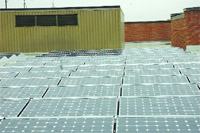
Shedding Some (Sun) Light on the Problem
STCC Expands Its Solar-power Capacity with a Second Photovoltaic Installation
Springfield Technical Community Colleges Building 20 is one of the largest and busiest on campus. It houses 14 health programs that run day and night, as well as the bookstore. There is a steady stream of traffic in and out of the building, even in summer, but few of those visitors are seemingly aware of its latest claim to fame.
Thats because it sits on the roof.
Specifically, its a solar-power array, believed to be the largest in the region and one of the largest in the state, comprised of 272 photovoltaic panels that will soon be turning sunshine into electricity.
At 82.9 kilowatts 2.5 times larger in overall energy production than the first installation the school put in three years ago across the street in the Technology Park at STCC the array will further reduce the schools carbon footprint and continue a program of expansion into alternative energy sources at the school.
Solar panels are not particularly economical to install, which is why the school funded the $663,000 project with a $407,000 grant from the Mass. Technology Collaborative and $256,000 worth of zero-interest clean renewable energy bonds (CREBs) from the IRS.
The new installation will save the school an additional $19,000 a year. Its only a nibble (about 1.7%) out of the schools $1.1 million annual electricity bill, but STCC president Ira Rubenzahl calls the move toward renewable energy socially responsible, and one of many the college is undertaking.
Quick Study
The system will eventually pay for itself, although the school estimates it will take 18 years, maybe less if energy prices go through the roof (no pun intended). But according to Rubenzahl, in addition to reducing the schools carbon footprint, the system offers other benefits.
Namely, it adds value to the schools academic program. The earlier installation on Building 101 in the Technology Park was not easily accessible to students. In contrast, the college designed the installation on Building 20 (also known as the health sciences building) as a demonstration project. Anyone can walk up to observe the system firsthand.
Whats more, the Building 20 installation is hooked up to a Web-based data-acquisition system, which students can easily access to monitor the system and get readings on ambient temperature, power output, and accumulated energy. And because the system stores data for five years, students can compare output year over year.
Rubenzahl said that, increasingly, individuals and institutions such as STCC that plan to go into building design and construction need to understand renewable energy systems.
We already have a program where we train technicians to install photovoltaic systems, he said. Now were looking at injecting components of this class into other programs in architecture and civil engineering.
Another benefit of the installation has to do with the local economy. Rubenzahl believes that green projects on campus increase the potential of renewable energy companies taking root in the region.
We think clean energy is a fertile area of economic development, he said. The more we do with it on campus, the more it helps us to build relationships and plant the seeds for new companies.
Tinkertoy Installation
Once STCC gathered approvals for its new photovoltaic installation, the rest was easy. Eric Ness, STCCs vice president of campus facilities, called it a Tinkertoy installation.
The 305-watt panels, made by SunPower Corp., arrived in boxes. Assembly essentially involved taking the panels out of the boxes and running the electrical cables.
We started setting up at the end of April, and Ive never seen more than two to three workers on the roof at a time, said Ness. It was just a matter of bolting the things together and setting them out on the roof.
Silent and unobtrusive, solar panels produce clean energy. A panel contains an array of photovoltaic cells that use semiconductors to convert sunlight into direct current. The cells produce energy even on overcast days. An inverter, located in the basement of Building 20, converts direct current into alternating current to power lights, air conditioners, and other appliances.
The STCC campus is an ideal place for photovoltaic installations, said Ness. Its natural elevation and tall buildings with flat roofs ensure the solar panels get plenty of sunlight.
Meanwhile, the school picked Building 20 for its latest installation because the structure has a new roof. Solar panels have a 30-year lifespan, and users dont want them going on an old roof that needs replacement in the near future.
Compared to the previous Tech Park installation, which is fix-mounted to the roof with bolts, the newer installation on Building 20 simply sits on the roof without damaging the roofs membrane. In fact, the school did not even need a building permit for the installation.
More to Come
With plenty of flat roofs on its campus, STCC has room for more photovoltaic installations down the road. At the same time, the school is tracking new developments in ground-powered arrays and arrays that concentrate sunlight with the use of parabolic mirrors.
A lot can be done in improving the efficiency of collecting light energy and transmitting it into electricity, explained Ness.
Until then, STCC is taking things one roof at a time.





